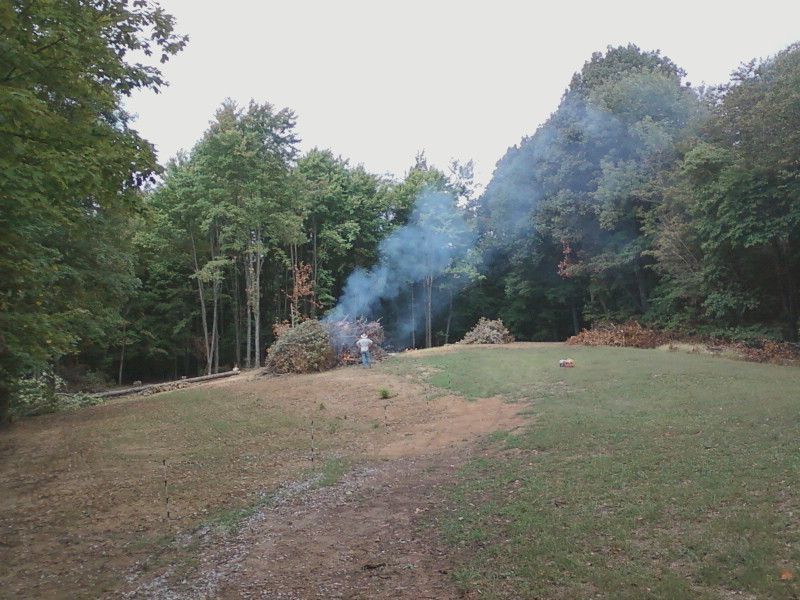Being retired, my wife and I plan to set up a trailer on our daughter's VERY rural property in southern Indiana for a getaway place. We bought an old Coachmen 28 ft. trailer that was in fair shape. It had been used hard, but not abused.
So far I have fixed the leaky roof (don't they all leak?), installed all new vents topside, rebuilt the bed and the couch, redone all the 12 volt wiring (it will be off-grid), replaced the fridge with a new one, and replumbed the gas for the kitchen stove with new tanks and all new regulators and hoses.
With only 2 of us in there, we are converting a lot of bunks to storage space, mostly just removing old bedding and finding suitable storage totes to fit. This part is evolving as we slowly stock the trailer with duplicate things from our home.
This will be a permanent installation, so we have a slab poured, 20' x 36' for it to park on. It will get jacked up onto blocks and tied down to rings I weld onto the steel frame. A shelter house style roof will go over the top the size of the slab, making us a 'front porch' about 10 ft. x 36 ft. and facing south.
I have bought a truck 'reefer' box, 8' x 8' x 20' to park behind the trailer on railroad ties for a lockable storage shed and workshop. It will be delivered this summer after I clear more trees from the site.
The idea is to have a combination BOL and retirement place for when we get too old and tired to keep up with the work at home. Here's a shot of the location, when we were clearing trees and burning brush last Fall.

Those trees average about 75 feet tall, and are mostly maples. We are cutting a lot of firewood, since they are too small for sawing lumber. I need to assure there is plenty of cleared area around the trailer because these trees do blow down with some regularity, being too small and too tall. The location is on a hilltop, with 300 ft. deep gorges on both sides, right and left in the photo. Great view!
So far I have fixed the leaky roof (don't they all leak?), installed all new vents topside, rebuilt the bed and the couch, redone all the 12 volt wiring (it will be off-grid), replaced the fridge with a new one, and replumbed the gas for the kitchen stove with new tanks and all new regulators and hoses.
With only 2 of us in there, we are converting a lot of bunks to storage space, mostly just removing old bedding and finding suitable storage totes to fit. This part is evolving as we slowly stock the trailer with duplicate things from our home.
This will be a permanent installation, so we have a slab poured, 20' x 36' for it to park on. It will get jacked up onto blocks and tied down to rings I weld onto the steel frame. A shelter house style roof will go over the top the size of the slab, making us a 'front porch' about 10 ft. x 36 ft. and facing south.
I have bought a truck 'reefer' box, 8' x 8' x 20' to park behind the trailer on railroad ties for a lockable storage shed and workshop. It will be delivered this summer after I clear more trees from the site.
The idea is to have a combination BOL and retirement place for when we get too old and tired to keep up with the work at home. Here's a shot of the location, when we were clearing trees and burning brush last Fall.

Those trees average about 75 feet tall, and are mostly maples. We are cutting a lot of firewood, since they are too small for sawing lumber. I need to assure there is plenty of cleared area around the trailer because these trees do blow down with some regularity, being too small and too tall. The location is on a hilltop, with 300 ft. deep gorges on both sides, right and left in the photo. Great view!

 If I had to, I could run the generator for a time and use a blow dryer to thaw something, worst case, but I'd rather design my way around such things. I guess I could run a 4" heat duct into the water entrance box and put a 12 volt muffin fan on it to take heat from the trailer down there.
If I had to, I could run the generator for a time and use a blow dryer to thaw something, worst case, but I'd rather design my way around such things. I guess I could run a 4" heat duct into the water entrance box and put a 12 volt muffin fan on it to take heat from the trailer down there. 